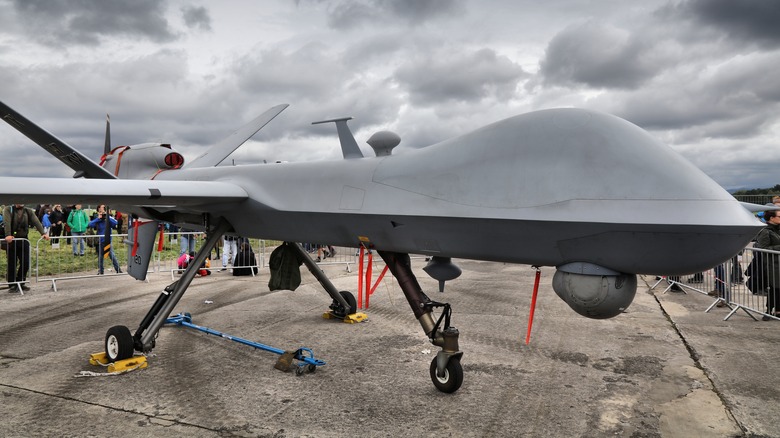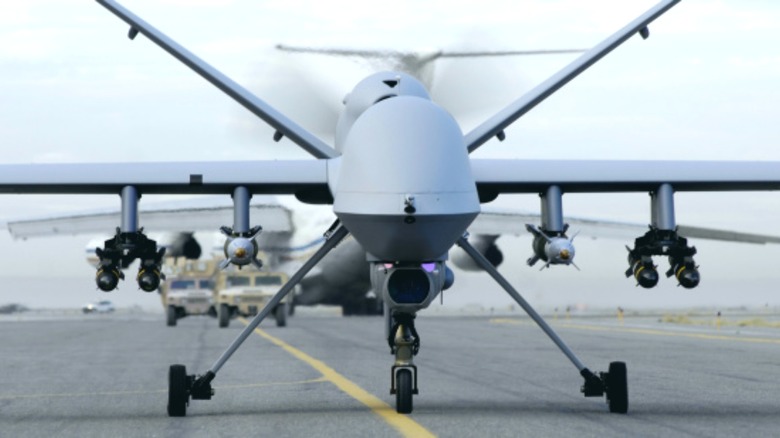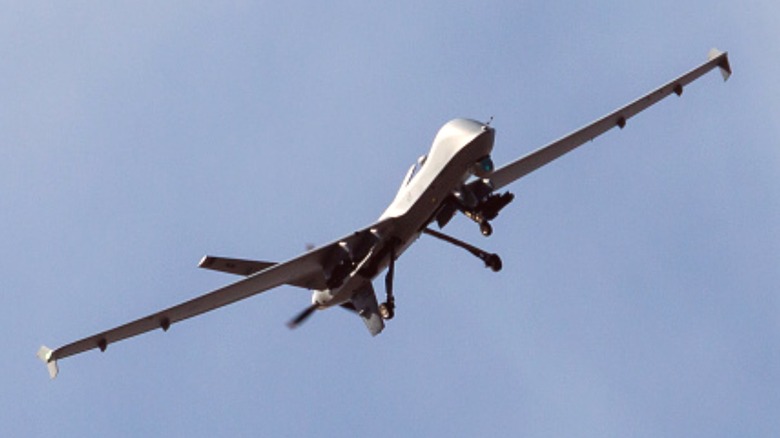How Fast Is The MQ-9 Reaper Drone & What Does One Of These Military UAVs Cost?
The U.S. military has been using and advancing drone technology for decades, and in the 21st century, drone warfare has become the norm. Throughout its conflicts in Iraq and Afghanistan (as well as neighboring nations in the Middle East), the U.S. has operated the largest and deadliest drone force ever to engage in combat, and the fleet continues to grow. One of the most reliable unmanned aircraft systems (UAS) operated by the U.S. military is the MQ-9 Reaper.
Reapers are fast, reaching speeds of 230 mph, and they share many similarities with the MQ-1 Predator. Both are manufactured by General Atomics and are controlled by the same ground-based systems, so the Reaper's introduction to the battlespace in 2007 and beyond was easy to integrate. Like most pieces of military technology, Reapers are among the best military drones in the world, but they aren't cheap. A single unit in 2011 cost the government $56.5 million.
These units included four aircraft with sensor packages, a ground control station, and a link to the Predator Primary satellite. More than 300 MQ-9s have been built since its introduction, and it's served the U.S. military well in a variety of operations, including combat air support (CAS), intelligence, surveillance, and reconnaissance (ISR), combat search and rescue (CSAR), and precision strike, among others. Reapers are highly versatile and capable platforms that don't put anyone flying them at risk, which makes them ideal for military operations around the world.
The MQ-9 Reaper
From the outside, the MQ-9 Reaper looks a lot like a MQ-1 Predator, but it's much larger and capable of carrying more ordnance. The Reaper's wingspan is 66 feet, its length is 36 feet, and it stands 12.5 feet in height. The Reaper carries 602 gallons (4,000 lbs.) of fuel and has a maximum takeoff weight of 10,500 lbs. This enables the Reaper to carry a maximum payload of 3,750 lbs., and its cruise speed is around 230 mph.
A Reaper can fly a total distance of 1,150 miles at an altitude of 50,000 feet. A Reaper can loiter over a target area to provide CAS and other functions throughout its flight time, which is a maximum endurance of 27 hours. The Reaper's ability to stay airborne for so long makes it an ideal candidate for a variety of missions, and its armament makes it especially dangerous for targets within its range.
A Reaper can carry a variety of munitions, including a combination of several, so they can carry out hunter killer missions if necessary. Most often, Reapers are outfitted with AGM-114 Hellfire missiles, GBU-12 Paveway II laser-guided bombs, GBU-38 Joint Direct Attack Munitions, GBU-54 Laser Joint Direct Attack Munitions (JDAM), and GBU-49 Enhanced Paveway II laser-guided bombs. Using these munitions, the Reaper can support numerous operations and take out high-value targets.
The Reaper's future
The MQ-9 Reaper has provided ISR and forward strike capabilities since its debut in 2007, and it's proven itself time and time again. Despite this, the Reaper has several disadvantages that make it less than ideal for future military operations. Most notably, the Reaper is relatively slow, flying at a maximum speed of 230 mph. The Reaper has plenty going for it despite its speed, including its cost-effectiveness for the coverage it provides.
Still, the U.S. Air Force made the decision to retire the MQ-9 Reaper. The Reaper won't cease operations for quite some time, as it will take some time to phase them out of the inventory. The USAF has plans to end its Reaper program by 2035, so there's still more than a decade of time in the Reaper's lifespan — at least, for the U.S. Ultimately, it may be sold to foreign nations as the U.S. advances its UAS fleet with newer models.
While it's not currently known precisely what the Reaper's replacement will look like, General Atomics is working on a new UAS. The MQ-Next will be a hybrid-electric UAS, which may include a flying-wing design. It's likely the MQ-Next will also have stealth capabilities and a longer endurance, and it could even carry more munitions. It will be some time before the Reaper steps aside for the next big thing, and in the meantime, the Reaper continues to fly in support of U.S. military operations abroad.


